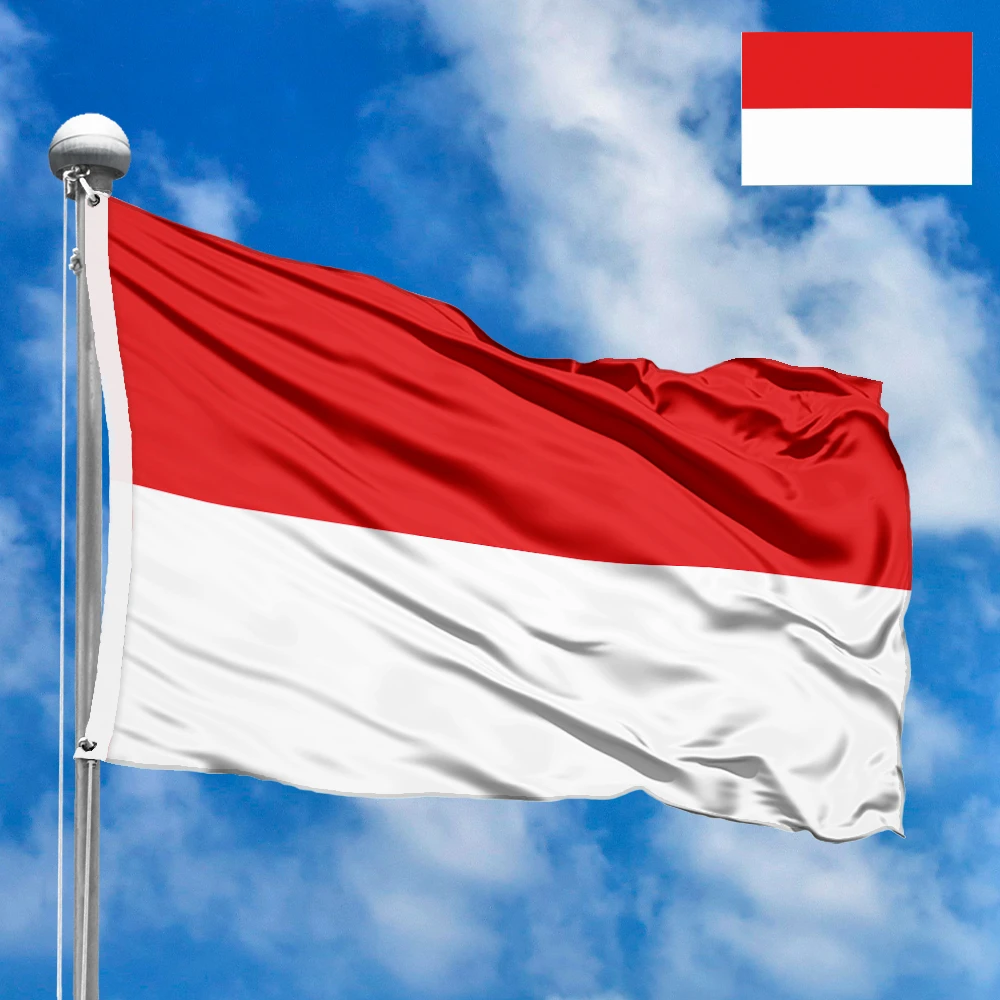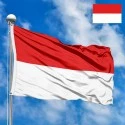The national flag of Indonesia, known as "Sang Saka Merah Putih" (The Lofty Red and White), is a powerful and iconic symbol deeply ingrained in the nation's identity and history. Its simple yet profound design represents the enduring spirit of the Indonesian people, their long struggle for independence, and their hopes for a prosperous future. This flag, formally adopted with the declaration of independence in 1945, is a direct link to ancient traditions and a testament to the nation's sovereignty.
Design and Dimensions
The flag of Indonesia is a bicolor consisting of two equal horizontal stripes. The top stripe is red, and the bottom stripe is white. It's a remarkably straightforward design, yet it carries immense historical and philosophical weight for the Indonesian people.
The official and legally mandated proportions for the Indonesian flag are 2:3 (height to width), giving it a distinctive rectangular shape. This proportion is crucial for maintaining its visual integrity and adherence to national standards.
Symbolism of the Colors
The two colors on the Indonesian flag, red and white, are not arbitrary choices; they are imbued with deep philosophical and historical meanings that resonate with the cultural fabric of the archipelago:
-
Red (Merah): The red stripe symbolizes bravery, courage, and the physical life of human beings. It represents the blood that has been shed throughout Indonesia's long history of struggle against colonialism, the fighting spirit of its people, and their unwavering determination to achieve and maintain independence. Red is also associated with the color of sugar palm, a traditional staple food in Indonesia, further connecting it to the land and its people.
-
White (Putih): The white stripe symbolizes purity, honesty, and the spiritual life of human beings. It represents the pure intentions of the Indonesian people, their moral integrity, and their aspirations for peace and justice. White is also associated with the color of rice, another staple food, reinforcing its connection to the nation's sustenance and well-being.
Together, the red and white symbolize a harmonious duality, representing the union of physical and spiritual life, or heaven and earth, a concept deeply rooted in ancient Indonesian philosophy (e.g., in Javanese mythology, red represents the physical aspect, and white represents the spiritual). This dual symbolism underscores the holistic identity of the Indonesian nation.
History of Creation and Adoption
The origins of the red and white flag in the Indonesian archipelago stretch back centuries, far preceding the modern nation-state. This ancient lineage gives the flag a unique depth and cultural resonance.
-
Ancient Origins (Majapahit Empire): The red and white motif has been documented as the banner of the powerful Majapahit Empire, which flourished in the 13th to 16th centuries and held sway over much of what is now Indonesia. This historical connection lends immense prestige and legitimacy to the flag, linking modern Indonesia to a glorious past. Historical records indicate that red and white flags were flown in various parts of the archipelago long before the arrival of European colonial powers, often representing local kingdoms and maritime power.
-
Colonial Era and Nationalist Revival: During the Dutch colonial period (from the 17th century), the use of local flags was suppressed. However, the red and white colors persisted as a symbol of defiance and national aspiration among Indonesian nationalists. In the early 20th century, as nationalist movements gained momentum, the red and white flag began to reappear.
-
Youth Pledge (Sumpah Pemuda) 1928: The red and white flag was prominently displayed during the Youth Pledge (Sumpah Pemuda) congress in 1928, a pivotal moment for Indonesian nationalism where youth organizations pledged to strive for "one nation, one homeland, and one language" (Indonesia). This marked a significant step toward its adoption as a national symbol.
-
Prohibition and Underground Use: The Dutch colonial government, recognizing the flag's growing symbolic power, strictly prohibited its display. This prohibition only served to elevate its status as a symbol of resistance and unity, leading to its widespread use in underground nationalist movements.
-
Declaration of Independence (1945): On August 17, 1945, when Indonesia declared its independence from Dutch rule, the "Sang Saka Merah Putih" was formally hoisted as the national flag. This momentous occasion cemented its status and forever linked it to the birth of the Republic of Indonesia. The first flag was sewn by Fatmawati, the wife of Sukarno, Indonesia's first president, adding a deeply personal and nationalistic touch to its origin.
-
Official Codification: The design and use of the flag were further codified in Indonesian law and constitution following independence, establishing its precise proportions and symbolic significance.
Significance for the Inhabitants
For the people of Indonesia, "Sang Saka Merah Putih" is far more than just a national emblem; it is a sacred object and a powerful representation of their collective identity, sacrifices, and aspirations.
-
Symbol of Sovereignty and Independence: It is the primary symbol of Indonesia's sovereignty and hard-won independence. Every time the flag is hoisted, it serves as a reminder of the long and arduous struggle against colonial rule and the determination of the Indonesian people to chart their own destiny.
-
National Unity and Diversity: In a nation as vast and diverse as Indonesia, with hundreds of ethnic groups and languages, the flag serves as a crucial unifying symbol. It transcends regional differences and fosters a sense of shared national identity.
-
Respect and Reverence: The flag is treated with immense respect and reverence. Specific protocols govern its display, handling, and retirement, reflecting the deep national pride associated with it. Any disrespect shown to the flag is considered a serious offense.
-
Historical Continuity: Its ancient origins connect modern Indonesians to their glorious past, particularly the Majapahit Empire, giving them a profound sense of historical continuity and cultural heritage.
-
Inspiration for Future Generations: The flag inspires future generations to uphold the values of courage, purity, and unity, reminding them of the foundations upon which the nation was built.
Interesting Facts
-
One of the Oldest Flag Designs: The red and white bicolor design is one of the oldest national flag designs still in use, with its roots tracing back to the Majapahit Empire in the 13th century.
-
Simplicity and Power: Its simplicity makes it instantly recognizable and memorable, yet its symbolism is deeply profound, embodying core Indonesian values.
-
Similarity to Monaco's Flag: The Indonesian flag is strikingly similar to the flag of Monaco, differing only in their proportions (Indonesia: 2:3; Monaco: 4:5). This often leads to confusion, though both nations independently adopted their designs based on their unique historical contexts.
-
"Merah Putih" as a National Nickname: The term "Merah Putih" (Red White) is often used colloquially as a nickname for Indonesia itself, reflecting how deeply the flag is intertwined with the national identity.
-
The First Flag (Sang Saka Merah Putih Pusaka): The original flag hoisted on August 17, 1945, became known as "Sang Saka Merah Putih Pusaka" (The Sacred Heirloom Red and White). Due to its age and fragility, it was retired from official flag-raising ceremonies in 1969 and is now preserved in the National Monument (Monas) in Jakarta. Replicas are used for ceremonies.
-
Color Meanings Across Cultures: While red and white are common flag colors globally, their specific philosophical interpretations (physical/spiritual, bravery/purity) are uniquely rooted in Indonesian traditional thought.
-
Used by Nationalist Youth Organizations: Before formal independence, the red and white flag was a powerful rallying point for numerous nationalist youth organizations, highlighting its role in mobilizing the independence movement.
-
Unchanged Design: Despite numerous political changes and upheavals in Indonesia's modern history, the core design of the red and white flag has remained consistently unchanged since 1945, emphasizing stability and national resolve.
In the demonstration images, full-size flags are shown with proportions of 2:3, and hand-held flags with proportions of 1:2.






 Waving flag
Waving flag
 Sizes:
Sizes:
 Round flag
Round flag
 Sizes:
Sizes:
 Rectangular flag 2:3
Rectangular flag 2:3
 Sizes:
Sizes: